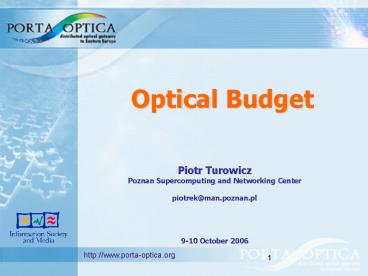Prezentacja programu PowerPoint - PowerPoint PPT Presentation
Title:
Prezentacja programu PowerPoint
Description:
Title: Prezentacja programu PowerPoint Author: Piotrek Last modified by: x Created Date: 9/3/2006 8:12:33 AM Document presentation format: – PowerPoint PPT presentation
Number of Views:52
Avg rating:3.0/5.0
Title: Prezentacja programu PowerPoint
1
Optical Budget
Piotr Turowicz Poznan Supercomputing and
Networking Center piotrek_at_man.poznan.pl 9-10
October 2006
http//www.porta-optica.org
2
Introduction
- When planning a new network or expanding an
existing - one with WDM equipment, one of the first things
to consider is - the distance between the equipment nodes.
- Distance is related to fiber-optic parameters
like - dispersion
- attenuation.
- Precise attenuation calculations should take
place at the planning stage. - The actual fiber optic cable attenuation should
be measured - or calculated based on the cable vendor
specifications and - the network segments distances.
3
Technical design elements Terminology
- Decibels (dB) used for power gain or loss
- Decibels-milliwatt (dBm) used for output power
and receive sensitivity - Attenuation loss of power in dB/km
- Chromatic dispersion spreading of the light
pulse in ps/nmkm - Bit Error Rate (BER) typical acceptable rate is
10-12 - Optical Signal to Noise Ratio (OSNR) ratio of
optical signal power to noise power for the
receiver - ITU Grid Wavelength standard for the lasers in
DWDM systems
4
Technical design elementsDecibel scale
The decibel (db) represents the logarithmic
relation of two power levels P1 and P2 usually
measured in watts. dB10log(P1/P2) Decibels
also can measure power relative to certain
levels. For example, when P20.001 Watt, the
value units will be called dBm, which means
power related to 1 milliwatt. dBm10log(P1
/1mW)
5
Technical Design Elements Optical Budget
- Optical budget Output power Input sensitivity
- Optical budget is affected by
- Fiber attenuation
- Splices
- Patch panels / connectors
- Optical components (filters, amplifiers, etc.)
- Bends in the fiber
- Contamination (dirt, oil, etc.)
6
Technical Design Elements Power Penalties
Penalty Ranking Fiber loss (attenuation) Spli
ces Connectors Dispersion Penalties Fiber
Nonlinearities Penalties Component / Fiber
Aging Penalties Transforms the signal from
this
to this
High to Low
7
Technical Design ElementsPenalties
Attenuation pulse amplitude reduction limits
how far Chromatic Dispersion spreading of
the pulse from different colored light traveling
at different speeds within the fiber Polarizati
on Mode Dispersion spreading of the light pulse
from fast and slow axes having different group
velocities
8
Fiber attenuation measurements
Fiber optic cables perform differently at various
wavelengths, so its cardinal to set the power
meter at the correct wavelength as well as to
match it with the light source. For example, WDM
technology uses the 1550 nm region, so its more
practical to test the cable with the same
wavelength of 1550 nm, if we plan to use it for
WDM transmission
9
Fiber attenuation measurements
The first step is measuring the launched power
from the transmitting device. Using launch
patch instead of a direct connection to the
transmitter eliminates the influence of the
transmitter - cable connection attenuation.
10
Fiber attenuation measurements
The cable under test will connect between the
launch patch and the receive patch, in order
to eliminate any non-cable related attenuations.
11
Fiber attenuation measurements
Cable attenuation (-3dbm) - (-10dbm) 7db
12
Optical network attenuation
Without amplification, the maximum allowable loss
in an all-optical network is given by the
difference between the launch power and the
receiver sensitivity. Allowable loss (dB)
Tx_power Rx_sensitivity
Of course, this value is true only if we connect
transponders directly to the transmission fiber.
13
Optical network attenuation
It is very useful to be able to specify in dB an
absolute power wi watts or in mW
To do this the power P2 in the dB formula is
fixed at some agreed reference value, so the dB
value always relates to this reference power
level.
Allows for easy calculation of power at any point
in a system
Where the reference power is 1mW the power in an
optical signal with a power level P is given in
dB as Power dB 10 Log P/1nW
14
dBm calculation (Transitter)
A transmitter laser has a measure output power of
2.3mW. What is the laser diode output power
expressed in dBm?
2.3mW
Transmitter laser
Power dB 10 Log (Power /1 mW)
Power dB 10 Log (2.3mW /1 mW)
Power dB 10 Log (2.3) 3.61dBm
15
dBm calculation (Transitter)
- dB and dBm can be combined in the same calculation
- As shown a fiber span (inc. splices etc.) has a
total attenuation of 13 dB
- If the trasmitter output power is 2 dBm what is
the reciver input power in dBm?
2 dBm
? dBm
Reciver
Transmitter
Fiber span att 13dB
Reciver input dB Transmitter output power
Total fiber span att. Reciver input dB 2 dBm
13 dB Reciver input dB -11 dBm
16
Point-to-Point link attenuation calculation
4 km
2 km
3 km
5 km
RX
TX
Connection
Connection
Splice
Connection
Components Fiber SM 9/125 14 km at 0.25dB
3.5 Connector 3 pcs. at 0.5dB 1.5 Splice 6
pcs. at 0.1dB (0.15dB) 0.6___ Total
attenuation 5.6 dB
17
Point-to-Point link attenuation calculation
The table contains some typical numbers, which
can be used to approximate optical link budget
calculations. If at all possible, real numbers
from the network in question should be used.
Standard for connector loss 0.5 dB
Typical cable attenuation at 1310nm 0.4 dB
Typical cable attenuation at 1550nm 0.25 dB
Typical splice attenuation 0.1 dB
Typical distance between splices 6 km
Typical safety margin 3 dB
) CD penalty 1 dB
18
Optical Budget Calculator
Minimum Transmit Power _________ Minimum Receive
Sensitivity - _________ Available Power
_________
_________ Km of cable X _________ dB/km
_________ _________ Connectors X
_________ dB/Con. _________ _________
Splices X _________ dB/splice
_________ Link Margin _________
_________ Repair Splices X _________ dB/Splice
_________ Safety Margin _________
Excess Power _________
19
Optical Budget Calculator
20
References
Reichle De-Massari
http//www.porta-optica.org































